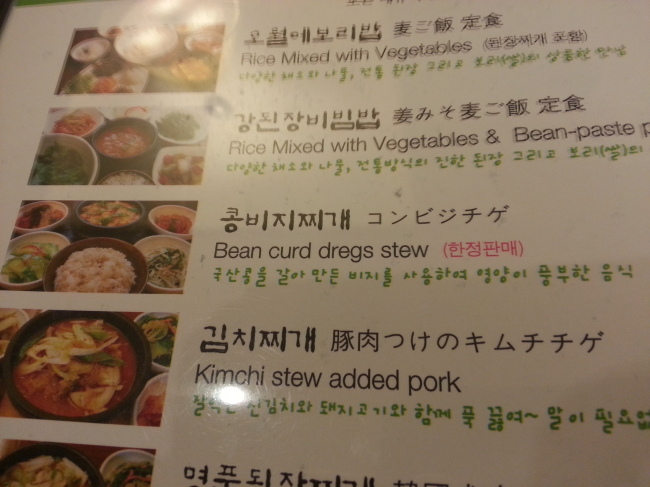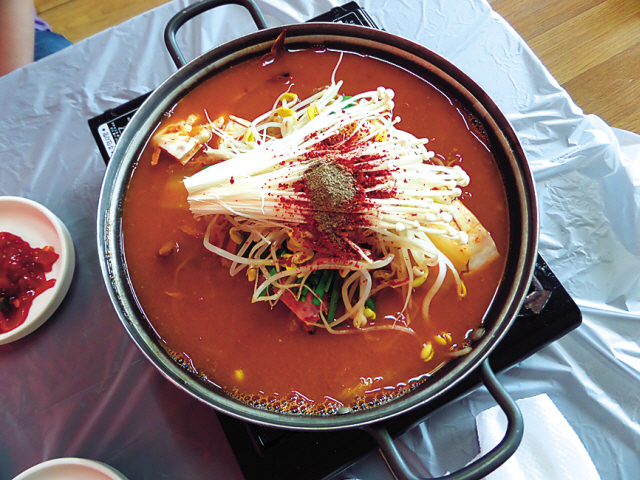No more ‘bean curd dregs’ ― Korea to standardize food translations
Culture Ministry looks to release English, Japanese and Chinese guidelines for translation of Korean dishes
By Korea HeraldPublished : Dec. 26, 2013 - 19:42

It goes without saying that expats living in Korea or international travelers have all experienced the tribulations of going into a Korean restaurant, reading the translated descriptions of the dishes and still having no idea exactly what they ordered.
With the hopes of minimizing these struggles for non-Koreans, the government will soon establish its latest project to release a descriptive guideline on Korean cuisine.
The Ministry of Culture, Sports and Tourism is planning to release an official set of translations of around 200 popular local dishes in English, Chinese and Japanese. The guideline is geared toward helping non-natives have a better grasp of Korean food.
In many cases, internationals may find themselves struggling to understand the Romanization of certain dishes. It is not uncommon for local restaurants to simply print-out menus listing a meal description spelling out the Korean term, such as “mandu” as opposed to “dumplings” or “jjigae” as opposed to “stew.”

And in other cases, especially in seafood restaurants, many menus use the scholastic or scientific terms for certain fish or plants ― names that the general public has probably never heard of.
“I think a guide would be helpful, but I’m not sure how the translations are going to turn out,” said Joe McPherson, founder of the online Korean food journal ZenKimchi. “These guidebooks have been done before. I fear that they will not consult native speakers.”
“There are some challenges in translating some dishes into English. Literal translations either give an inaccurate picture of a dish or make it sound unappetizing. Cultural connotations should also be considered,” he explained. “Kongbiji (a creamy puree of soaked soybeans) is a particularly tough one. I’ve seen it translated as ‘bean curd dregs’ and ‘soybean refuse.’ Both of those sound disgusting.”

McPherson, who has been working in the Korean food scene for the past decade, has often come across English translations of certain Korean dishes that were of little to no help. McPherson recalls in his early years in Korea, the issues of ordering dishes were not because of incorrect or confusing translation, rather because there was no translation ― which is still common among many local mom-and-pop restaurants.
The Korean food coinsurer remembers once going to a seafood restaurant with his brother and ordering something that he thought was a plate of fish. He ended up ordering a dish that was “basically a bunch of fish bones.”
McPherson claims that while a standardized guideline may be “more helpful to restaurants,” there are many instances where overly detailed translations may do more harm than good.
“The challenge comes in learning restraint. Not every dish and vegetable needs to be translated,” he said. “Many times the Korean word will suffice. The Japanese didn’t feel the need to call sushi ‘vinegared rice.’”
By Julie Jackson (juliejackson@heraldcorp.com)
-
Articles by Korea Herald







![[KH Explains] Hyundai's full hybrid edge to pay off amid slow transition to pure EVs](http://res.heraldm.com/phpwas/restmb_idxmake.php?idx=644&simg=/content/image/2024/04/18/20240418050645_0.jpg&u=20240419100350)







![[From the Scene] Monks, Buddhists hail return of remains of Buddhas](http://res.heraldm.com/phpwas/restmb_idxmake.php?idx=652&simg=/content/image/2024/04/19/20240419050617_0.jpg&u=20240419175937)

![[KH Explains] Hyundai's full hybrid edge to pay off amid slow transition to pure EVs](http://res.heraldm.com/phpwas/restmb_idxmake.php?idx=652&simg=/content/image/2024/04/18/20240418050645_0.jpg&u=20240419100350)

![[Today’s K-pop] Illit drops debut single remix](http://res.heraldm.com/phpwas/restmb_idxmake.php?idx=642&simg=/content/image/2024/04/19/20240419050612_0.jpg&u=)